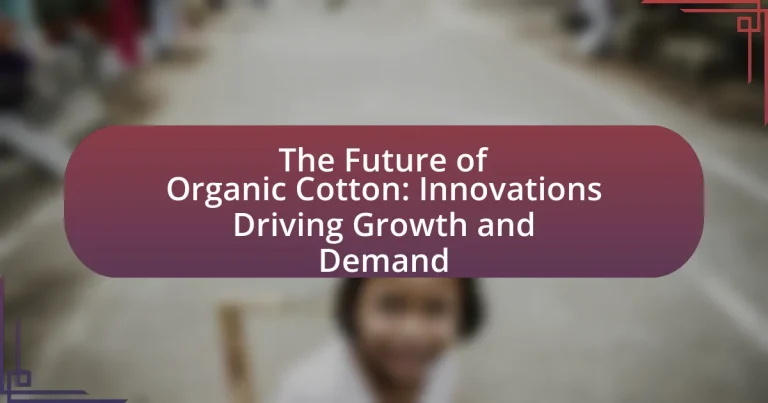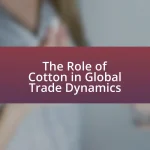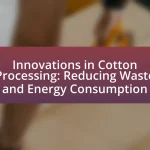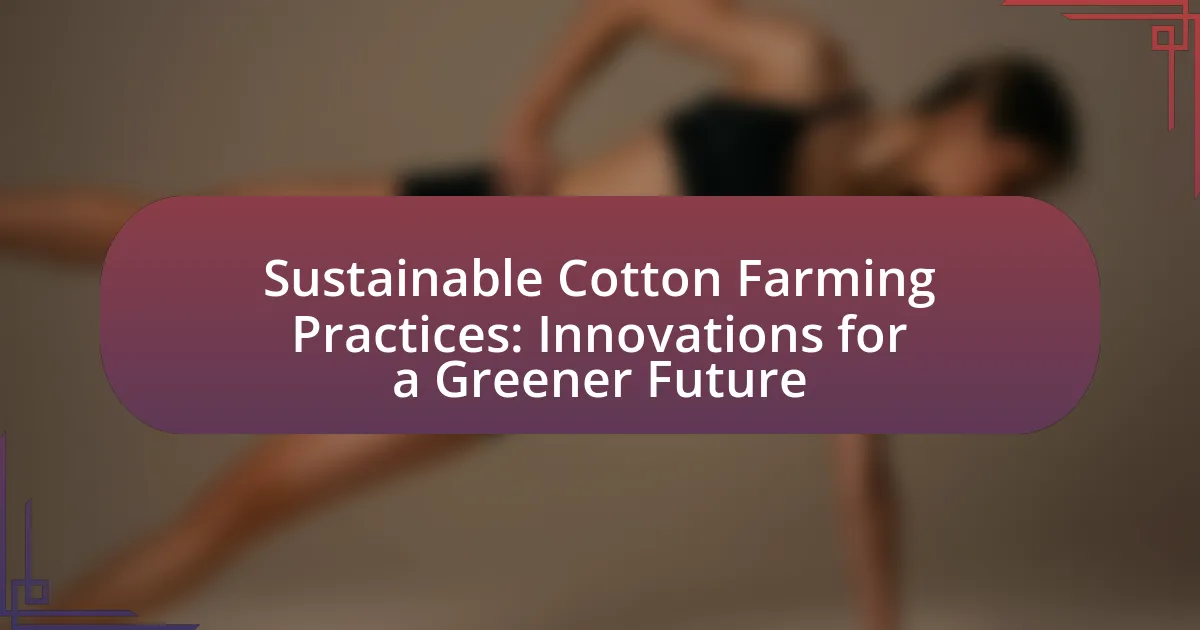The main entity of the article is organic cotton, which is increasingly recognized for its sustainable and eco-friendly attributes. The article outlines the significant growth potential of the organic cotton market, projected to expand at a compound annual growth rate of 10.5% from 2021 to 2026, driven by rising consumer demand for sustainable textiles. It details the production processes, key differences from conventional cotton, and the innovative farming practices that enhance organic cotton’s appeal. Additionally, the article discusses the economic impacts, challenges, and future outlook for organic cotton, emphasizing the role of consumer preferences and regulatory changes in shaping its market dynamics.
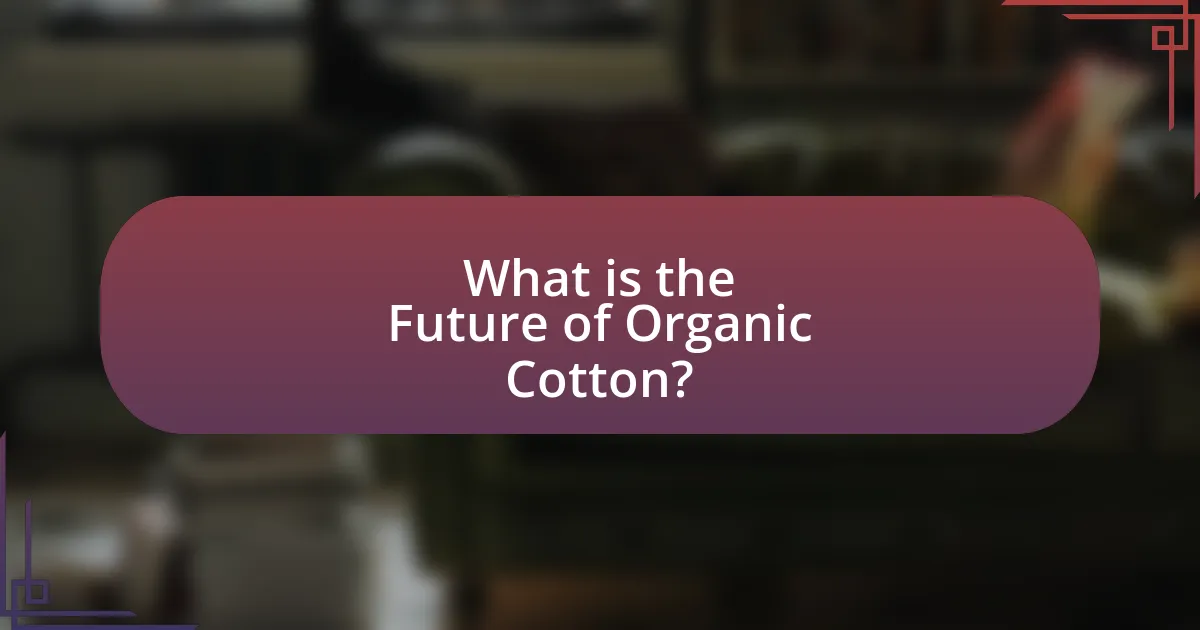
What is the Future of Organic Cotton?
The future of organic cotton is poised for significant growth driven by increasing consumer demand for sustainable and eco-friendly products. As awareness of environmental issues rises, consumers are increasingly prioritizing organic cotton for its reduced pesticide use and lower environmental impact compared to conventional cotton. According to a report by Research and Markets, the global organic cotton market is expected to grow at a compound annual growth rate (CAGR) of 10.5% from 2021 to 2026, indicating strong market potential. Innovations in farming practices, such as regenerative agriculture and improved supply chain transparency, are further enhancing the appeal of organic cotton, making it a key player in the sustainable textile industry.
How is organic cotton defined and produced?
Organic cotton is defined as cotton that is grown without the use of synthetic pesticides, fertilizers, or genetically modified organisms (GMOs). The production process involves adhering to strict agricultural practices that promote biodiversity and soil health, such as crop rotation and the use of organic fertilizers. According to the Global Organic Textile Standard (GOTS), organic cotton must be certified, ensuring that it meets specific environmental and social criteria throughout its lifecycle, from farming to processing. This certification process includes regular inspections and compliance with organic farming regulations, which are designed to protect the environment and the health of farmers.
What are the key differences between organic and conventional cotton?
Organic cotton is grown without synthetic pesticides and fertilizers, while conventional cotton relies on these chemicals for cultivation. Organic farming practices promote biodiversity and soil health, often using crop rotation and natural pest control methods, whereas conventional methods may lead to soil degradation and increased chemical runoff. According to the Global Organic Textile Standard, organic cotton must meet strict criteria, including non-GMO seeds and sustainable farming practices, which contrasts with conventional cotton’s less regulated production methods.
What farming practices are involved in organic cotton production?
Organic cotton production involves farming practices such as crop rotation, organic pest management, and the use of natural fertilizers. Crop rotation helps maintain soil fertility and reduce pest populations, while organic pest management employs beneficial insects and natural repellents instead of synthetic pesticides. Additionally, natural fertilizers, such as compost and green manure, enhance soil health without chemical inputs. These practices are validated by the Organic Trade Association, which states that organic farming methods contribute to sustainable agriculture and environmental health.
Why is the demand for organic cotton increasing?
The demand for organic cotton is increasing primarily due to heightened consumer awareness of environmental sustainability and health concerns. As consumers become more informed about the negative impacts of conventional cotton farming, such as pesticide use and water pollution, they are actively seeking eco-friendly alternatives. According to a report by Grand View Research, the global organic cotton market is projected to reach $10.5 billion by 2025, reflecting a compound annual growth rate of 24.3%. This growth is driven by the rising preference for sustainable textiles among consumers and brands, as well as the increasing availability of organic cotton products in the market.
What consumer trends are driving the growth of organic cotton?
The growth of organic cotton is primarily driven by increasing consumer demand for sustainable and eco-friendly products. Consumers are becoming more environmentally conscious, leading to a preference for organic cotton, which is produced without harmful pesticides and synthetic fertilizers. According to a report by Grand View Research, the global organic cotton market is expected to grow at a compound annual growth rate of 12.5% from 2021 to 2028, reflecting this rising trend. Additionally, the rise of ethical fashion movements and transparency in supply chains has further fueled interest in organic cotton, as consumers seek to support brands that prioritize sustainability and ethical practices.
How do environmental concerns influence the demand for organic cotton?
Environmental concerns significantly increase the demand for organic cotton as consumers become more aware of the negative impacts of conventional cotton farming on ecosystems. The use of harmful pesticides and fertilizers in traditional cotton production contributes to soil degradation, water pollution, and loss of biodiversity, prompting consumers to seek sustainable alternatives. According to a 2021 report by the Textile Exchange, the global market for organic cotton grew by 50% from 2018 to 2020, driven by heightened awareness of environmental issues and a shift towards sustainable fashion. This trend indicates that as environmental awareness rises, so does the preference for organic cotton, which is perceived as a more eco-friendly option.
What innovations are shaping the future of organic cotton?
Innovations shaping the future of organic cotton include advancements in sustainable farming practices, biotechnology, and supply chain transparency. Sustainable farming practices, such as regenerative agriculture, enhance soil health and biodiversity, leading to higher yields and reduced environmental impact. Biotechnology innovations, like genetically modified organisms that require fewer resources, are being explored to improve pest resistance and crop resilience. Additionally, supply chain transparency technologies, such as blockchain, enable consumers to trace the origin of organic cotton, ensuring ethical sourcing and boosting consumer confidence. These innovations collectively contribute to the growth and demand for organic cotton in the textile industry.
How is technology being integrated into organic cotton farming?
Technology is being integrated into organic cotton farming through precision agriculture, data analytics, and sustainable pest management systems. Precision agriculture utilizes GPS and IoT devices to monitor soil health, moisture levels, and crop growth, enabling farmers to make informed decisions that enhance yield while minimizing resource use. Data analytics platforms analyze historical and real-time data to optimize planting schedules and irrigation practices, leading to increased efficiency. Additionally, sustainable pest management systems employ technology such as drones and automated sensors to detect pest outbreaks early, allowing for targeted interventions that reduce chemical usage and align with organic farming principles. These technological advancements contribute to the overall growth and demand for organic cotton by improving productivity and sustainability.
What role do sustainable practices play in the innovation of organic cotton?
Sustainable practices are crucial in the innovation of organic cotton as they enhance environmental stewardship and improve resource efficiency. By implementing methods such as crop rotation, organic pest management, and water conservation techniques, farmers can increase soil health and reduce chemical inputs, leading to higher quality cotton production. Research indicates that organic cotton farming can use up to 91% less water compared to conventional methods, demonstrating significant resource savings. Furthermore, sustainable practices contribute to the development of new technologies and processes, such as biodegradable dyes and eco-friendly processing methods, which align with consumer demand for environmentally responsible products. This innovation not only meets market needs but also supports the long-term viability of cotton farming by promoting biodiversity and reducing carbon footprints.
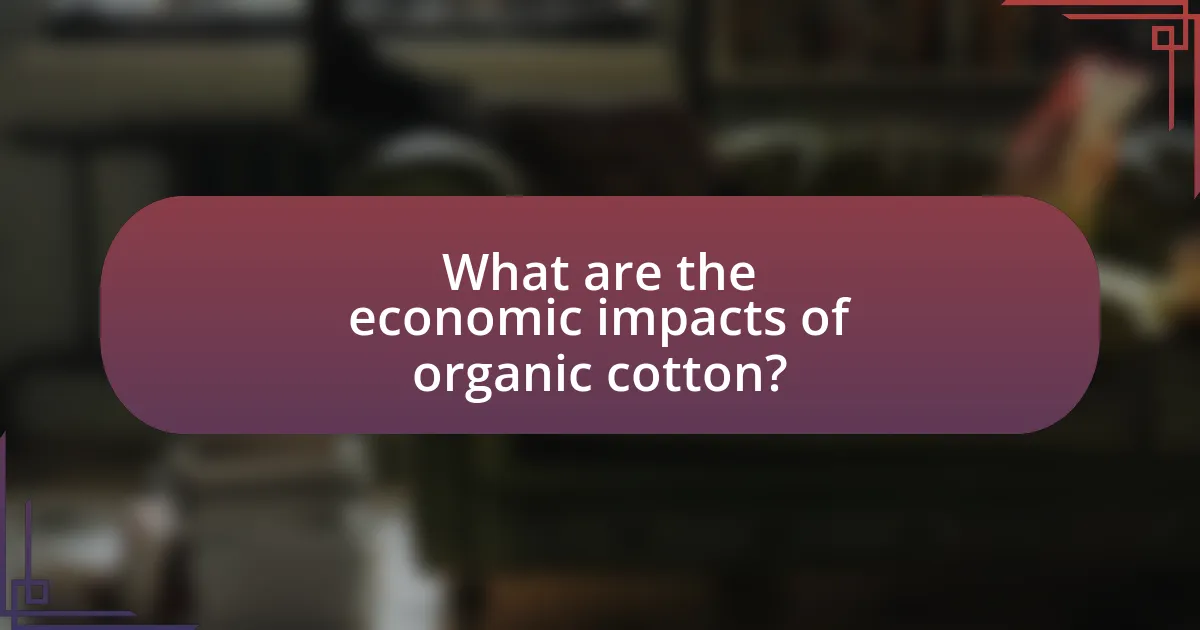
What are the economic impacts of organic cotton?
The economic impacts of organic cotton include increased income for farmers, reduced environmental costs, and enhanced market demand. Organic cotton farming typically yields higher prices for producers, with prices often 20-50% higher than conventional cotton, leading to improved livelihoods for farmers. Additionally, organic cotton cultivation reduces the need for synthetic fertilizers and pesticides, which lowers environmental remediation costs and promotes sustainable agricultural practices. The global market for organic cotton has been growing, with a reported increase in demand by 30% from 2018 to 2020, indicating a strong consumer preference for sustainable products. This trend not only benefits farmers economically but also stimulates job creation in the organic textile industry, further contributing to local economies.
How does organic cotton contribute to local economies?
Organic cotton contributes to local economies by creating jobs and promoting sustainable agricultural practices. The cultivation of organic cotton often requires more labor-intensive methods compared to conventional cotton, leading to increased employment opportunities for local farmers and workers. According to a study by the Textile Exchange, organic cotton farming can yield higher prices for farmers, which boosts their income and stimulates local economies. Additionally, organic cotton farming encourages the use of eco-friendly practices, which can enhance soil health and biodiversity, further supporting the local agricultural ecosystem and economy.
What are the financial benefits for farmers growing organic cotton?
Farmers growing organic cotton experience higher financial benefits compared to conventional cotton due to premium pricing, reduced input costs, and increased market demand. Organic cotton typically commands a price that is 20% to 50% higher than conventional cotton, reflecting consumer willingness to pay for sustainable products. Additionally, organic farming practices often lead to lower costs for synthetic fertilizers and pesticides, which can reduce overall production expenses. Furthermore, the global market for organic cotton is expanding, with a reported growth rate of 10% annually, driven by rising consumer awareness and demand for sustainable textiles. This combination of higher prices, lower costs, and increasing demand contributes significantly to the financial viability of organic cotton farming.
How does organic cotton affect global trade dynamics?
Organic cotton significantly influences global trade dynamics by shifting consumer preferences towards sustainable products, which in turn drives demand for organic textiles. This increased demand has led to a rise in the market share of organic cotton, with the global organic cotton market valued at approximately $1.5 billion in 2020 and projected to grow at a compound annual growth rate of 10% through 2027. As countries adopt stricter environmental regulations and consumers become more environmentally conscious, producers are incentivized to transition from conventional to organic farming practices. This transition not only impacts supply chains but also encourages investment in sustainable agricultural practices, thereby altering trade relationships and creating new market opportunities.
What challenges does the organic cotton industry face?
The organic cotton industry faces several significant challenges, including higher production costs, limited availability of organic seeds, and competition from conventional cotton. Higher production costs arise from the need for organic farming practices, which often require more labor and resources. Limited availability of organic seeds restricts farmers’ ability to cultivate organic cotton, as they may rely on a small number of suppliers. Additionally, competition from conventional cotton, which is typically cheaper due to subsidies and economies of scale, makes it difficult for organic cotton to gain market share. These challenges hinder the growth and demand for organic cotton in the textile industry.
What are the barriers to scaling organic cotton production?
The barriers to scaling organic cotton production include limited availability of organic seeds, higher production costs, and lack of infrastructure for processing and distribution. Limited availability of organic seeds restricts farmers’ ability to cultivate organic cotton, as they often rely on conventional seeds that may not meet organic standards. Higher production costs arise from the need for organic farming practices, which can be labor-intensive and require more resources compared to conventional methods. Additionally, inadequate infrastructure for processing and distribution hampers the ability to efficiently bring organic cotton to market, limiting its accessibility to consumers. These factors collectively hinder the growth potential of organic cotton production.
How do market fluctuations impact organic cotton prices?
Market fluctuations significantly impact organic cotton prices by influencing supply and demand dynamics. When demand for organic cotton increases, often due to rising consumer awareness and preference for sustainable products, prices tend to rise. Conversely, if there is an oversupply or a decrease in demand, prices can drop. For instance, in 2021, organic cotton prices surged by approximately 20% due to heightened demand from the fashion industry, which increasingly prioritizes sustainable materials. Additionally, external factors such as weather conditions, trade policies, and global economic trends can further exacerbate these price fluctuations, making the organic cotton market highly sensitive to both local and international market changes.

What is the future outlook for organic cotton?
The future outlook for organic cotton is positive, driven by increasing consumer demand for sustainable and eco-friendly products. The global organic cotton market is projected to grow at a compound annual growth rate (CAGR) of approximately 10% from 2021 to 2026, according to a report by Research and Markets. This growth is fueled by heightened awareness of environmental issues, the impact of conventional cotton farming on ecosystems, and a shift towards sustainable fashion practices. Additionally, innovations in organic farming techniques and supply chain transparency are expected to enhance the viability and appeal of organic cotton, further solidifying its position in the textile industry.
How will consumer preferences shape the future of organic cotton?
Consumer preferences will significantly shape the future of organic cotton by driving demand for sustainable and ethically produced textiles. As awareness of environmental issues increases, consumers are increasingly prioritizing products that align with their values, leading to a rise in the demand for organic cotton, which is grown without harmful pesticides and synthetic fertilizers. According to a report by Grand View Research, the global organic cotton market is expected to reach $9.5 billion by 2025, indicating a strong consumer shift towards sustainable options. This trend is further supported by surveys showing that over 70% of consumers are willing to pay more for sustainable products, reinforcing the notion that consumer preferences will dictate the growth and innovation within the organic cotton sector.
What predictions can be made about the growth of organic cotton markets?
The growth of organic cotton markets is predicted to increase significantly due to rising consumer demand for sustainable and eco-friendly products. Market research indicates that the global organic cotton market is expected to grow at a compound annual growth rate (CAGR) of approximately 10% from 2021 to 2026, driven by heightened awareness of environmental issues and the benefits of organic farming practices. Additionally, initiatives by brands and retailers to source organic cotton and the expansion of certification programs are further supporting this growth trajectory.
How might regulations affect the organic cotton industry in the future?
Regulations are likely to significantly impact the organic cotton industry in the future by establishing stricter standards for organic certification and sustainability practices. These regulations may enhance consumer trust and demand for certified organic products, as consumers increasingly seek transparency in sourcing and production methods. For instance, the USDA Organic Certification requires compliance with specific agricultural practices, which can lead to improved environmental outcomes and higher quality cotton. Additionally, regulations aimed at reducing pesticide use and promoting biodiversity can drive innovation in farming techniques, ultimately benefiting both producers and consumers in the organic cotton market.
What best practices can be adopted for sustainable organic cotton production?
Best practices for sustainable organic cotton production include crop rotation, intercropping, and the use of organic fertilizers. Crop rotation helps maintain soil fertility and reduces pest buildup, while intercropping can enhance biodiversity and improve pest control. Utilizing organic fertilizers, such as compost and green manure, enriches the soil without harmful chemicals. According to the Organic Trade Association, organic cotton farming can reduce water usage by up to 90% compared to conventional methods, demonstrating its environmental benefits. Additionally, implementing integrated pest management (IPM) strategies minimizes reliance on synthetic pesticides, promoting a healthier ecosystem.
How can farmers implement innovative techniques in organic cotton farming?
Farmers can implement innovative techniques in organic cotton farming by adopting precision agriculture technologies, such as soil sensors and drones, to optimize resource use and monitor crop health. These technologies enable farmers to make data-driven decisions, improving yield and sustainability. For instance, a study published in the journal “Agricultural Systems” found that precision agriculture can increase cotton yields by up to 20% while reducing water usage by 30%. Additionally, integrating cover cropping and crop rotation can enhance soil fertility and pest management, further supporting organic practices.
What resources are available for supporting organic cotton initiatives?
Resources available for supporting organic cotton initiatives include certification programs, funding opportunities, educational materials, and collaborative networks. Certification programs, such as the Global Organic Textile Standard (GOTS), provide guidelines for organic cotton production and processing, ensuring compliance with environmental and social criteria. Funding opportunities from organizations like the Organic Farming Research Foundation offer grants for research and development in organic agriculture. Educational materials from institutions like the Textile Exchange provide insights into best practices and market trends. Collaborative networks, such as the Organic Cotton Accelerator, connect stakeholders across the supply chain to promote sustainable practices and innovation in organic cotton production.
